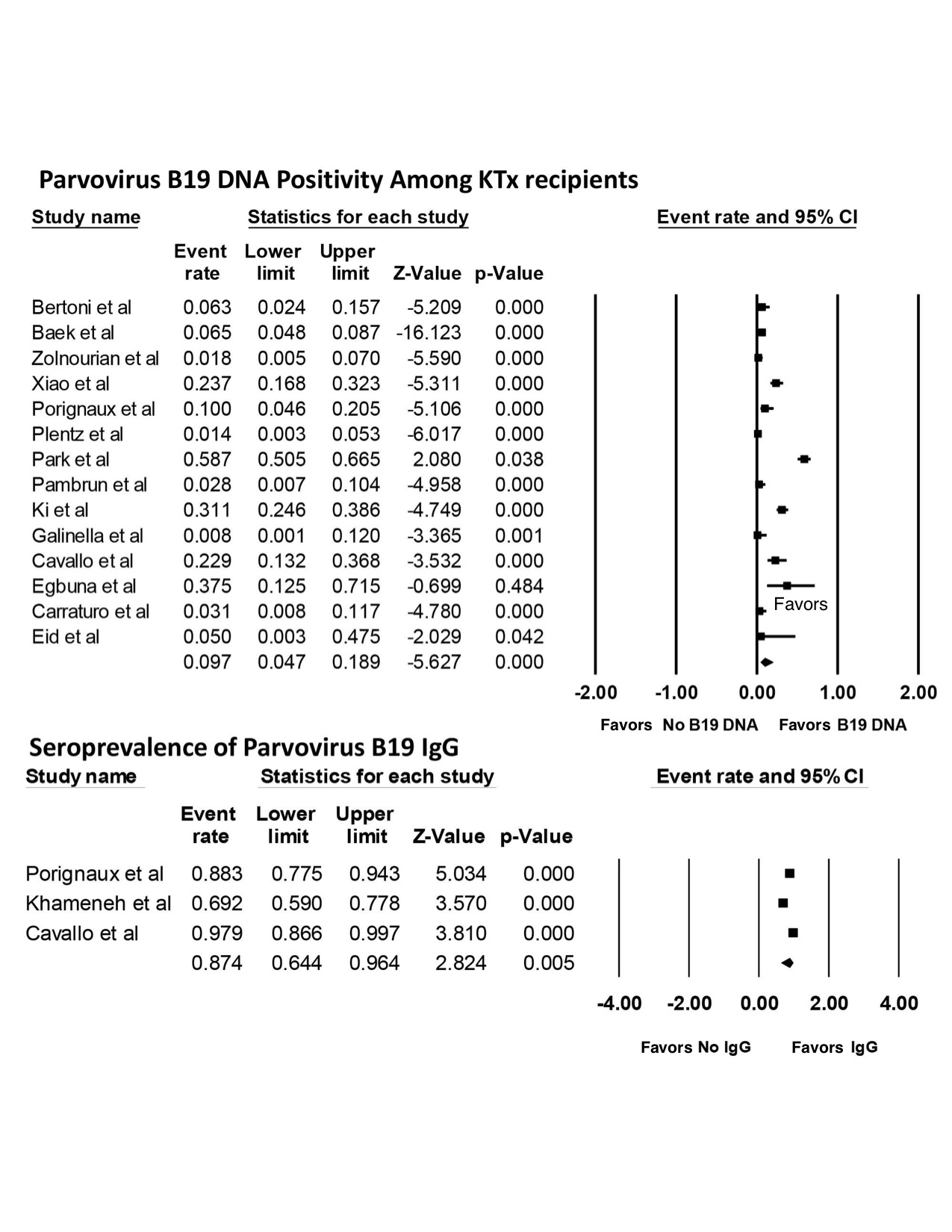Epidemiology of Parvovirus B19 and Anemia among Kidney Transplant Recipients
N. Khoury1, C. Thongprayoon2, N. Leeaphorn3, J. Bruminhent4, W. Cheungpasitporn5
1Henry Ford Transplant Institute, Detroit, MI, 2Mayo Clinic, Rochester, MN, 3University of Missouri, Kansas City, MO, 4Mahidol University, Bangkok, Thailand, 5University of Mississippi, Jackson, MS
Meeting: 2019 American Transplant Congress
Abstract number: B222
Keywords: Infection, Kidney, Kidney transplantation, Meta-analysis
Session Information
Session Name: Poster Session B: Kidney Infections
Session Type: Poster Session
Date: Sunday, June 2, 2019
Session Time: 6:00pm-7:00pm
 Presentation Time: 6:00pm-7:00pm
Presentation Time: 6:00pm-7:00pm
Location: Hall C & D
*Purpose: Persistent anemia has been described in kidney transplant (KTx) recipients with Parvovirus B19 virus infection. However, epidemiology of Parvovirus B19 and Parvovirus B19-related anemia after KTx remains unclear. The study’s aims were 1) to investigate the frequency of Parvovirus B19 infection and 2) to assess the incidence of Parvovirus B19-related anemia in KTx recipients.
*Methods: A literature search for studies that reported the occurrence rate of Parvovirus B19 infection and/or seroprevalence of Parvovirus B19 in KTx recipientswas conducted using Medline, Embase, and Cochrane Database from inception through October 2018. Effect estimates from the individual study were extracted and combined using random-effect, generic inverse variance method of DerSimonian and Laird.
*Results: 15 observational studies with a total of 1,757 KTx patients were enrolled. Overall, the pooled estimated seroprevalence of Parvovirus B19 IgG was 87.4% (95%CI: 64.4%-96.4%). The pooled estimated occurrence rate of positive Parvovirus B19 DNA in the first year after KTx was 9.7% (95%CI: 4.7%-18.9%). Sensitivity analysis excluding a study (that solely included KTx patients with anemia) was performed, and showed the pooled estimated occurrence rate of positive Parvovirus B19 DNA after KTx of 8.6% (95%CI: 4.0%-17.6%). Meta-regression analysis demonstrated no significant correlations between the year of study and occurrence rate of positive Parvovirus B19 DNA (P = 0.93). Among KTx recipients with positive Parvovirus B19 DNA, the pooled estimated incidence rates of anemia and severe anemia were 37.6% (95%CI: 25.8%-51.1%) and 22.3% (7.1%-51.9%), respectively. Egger’s regression asymmetry test was performed and showed no publication bias in all analyses.
*Conclusions: Parvovirus B19 infection occurs mostly within the first year post-transplant. The overall estimated occurrence of positive Parvovirus B19 DNA after KTX is 9.7%. The estimated incidence of anemia among KTx recipients with positive Parvovirus B19 DNA is 37.6%. Parvovirus B 19 should be ruled out in cases of persistent anemia after transplant.
To cite this abstract in AMA style:
Khoury N, Thongprayoon C, Leeaphorn N, Bruminhent J, Cheungpasitporn W. Epidemiology of Parvovirus B19 and Anemia among Kidney Transplant Recipients [abstract]. Am J Transplant. 2019; 19 (suppl 3). https://atcmeetingabstracts.com/abstract/epidemiology-of-parvovirus-b19-and-anemia-among-kidney-transplant-recipients/. Accessed December 14, 2025.« Back to 2019 American Transplant Congress

